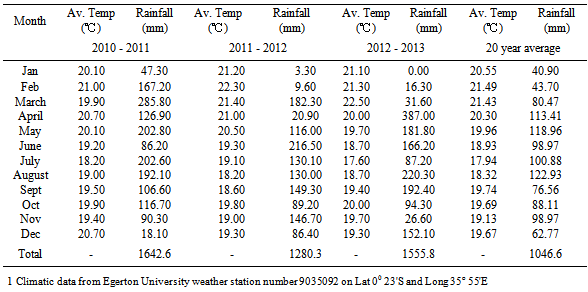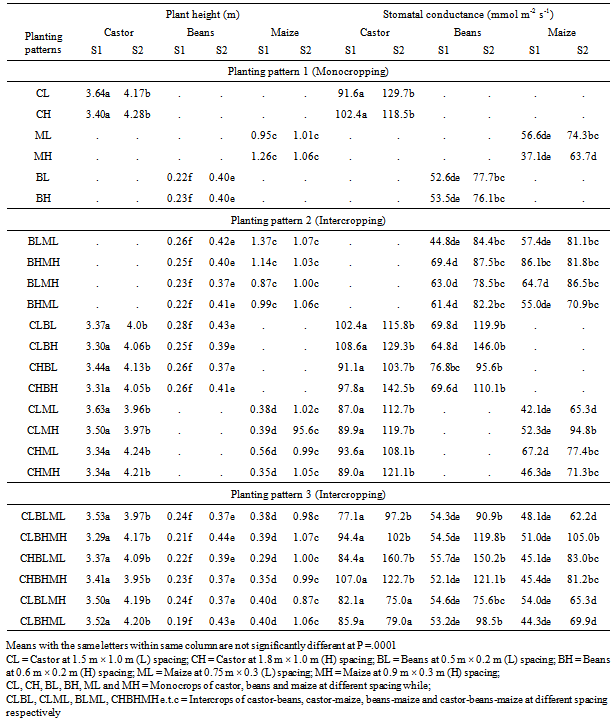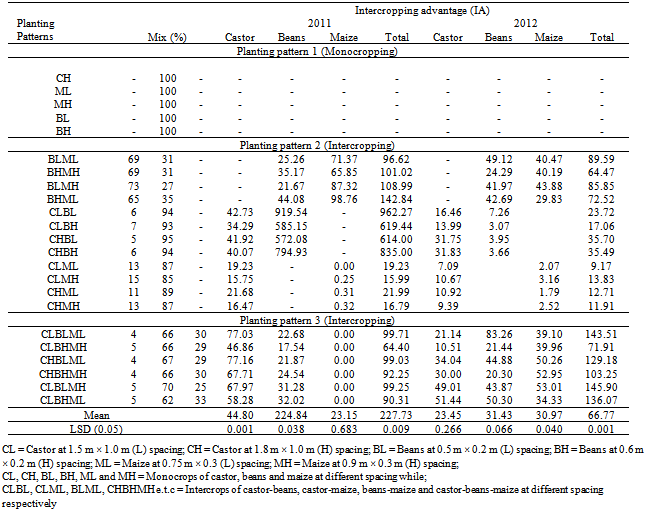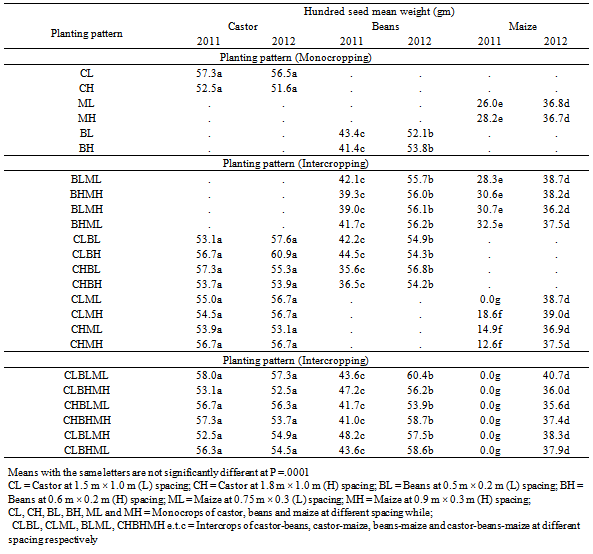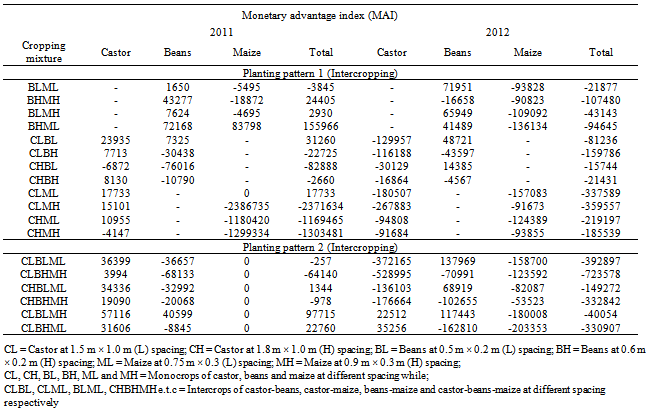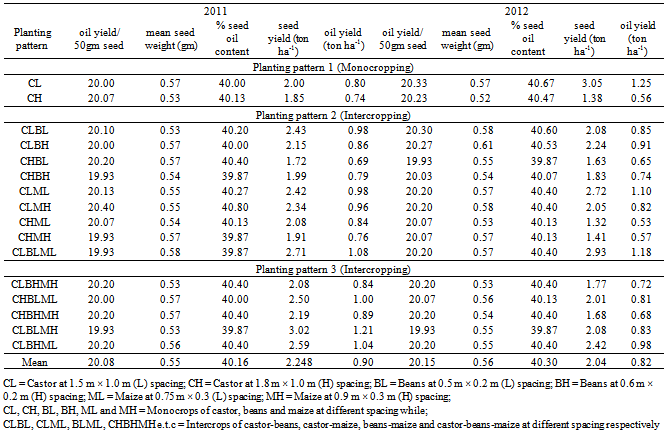-
Paper Information
- Previous Paper
- Paper Submission
-
Journal Information
- About This Journal
- Editorial Board
- Current Issue
- Archive
- Author Guidelines
- Contact Us
International Journal of Plant Research
p-ISSN: 2163-2596 e-ISSN: 2163-260X
2013; 3(4): 52-62
doi:10.5923/j.plant.20130304.02
Effect of Intercropping Castor with Maize and Beans on Growth, Yield and Seed Oil Content
Charles Obiero1, Rhoda Birech1, Joyce Maling’a2, Bernhard Freyer3
1Egerton University; Crops Horticulture and Soil Sciences Department, P. O. Box 536-20115, Egerton, Kenya
2Kenya Agricultural Research Institute (KARI-Kakamega), P. O. Box Private Bag, Kakamega, Kenya
3University of Natural Resources and Life Sciences (BOKU), Division of Organic Farming, Gregor Mendel Straße 33, 1180 Vienna, Austria
Correspondence to: Charles Obiero, Egerton University; Crops Horticulture and Soil Sciences Department, P. O. Box 536-20115, Egerton, Kenya.
| Email: |  |
Copyright © 2012 Scientific & Academic Publishing. All Rights Reserved.
In Kenya, smallholder farmers have been observed growing castor with maize and beans under an intercropping system amidst little knowledge that such a system could have on the performance of these crops. The objective of this study was to investigate the effect of intercropping castor with maize and beans on growth, yield and seed oil content. A 3 × 3 × 2 factorial experiment in randomized complete block design with three levels of crops, three levels of cropping system and two levels of spacing was laid-out at Egerton University farm for three seasons in 2010 to 2012. Results at P =.0001 level of significance indicated high seed yield for castor monocrops in the range of 2.0 - 3.0 tons seeds ha-1 yr-1; while an intercrop of castor at (1.5 m × 1.0 m) with beans at (0.5 m × 0.2 m) spacing showed best cropping mixtures recording yields ranging from 2.15 - 2.43 and 0.3 - 0.83 tons seeds ha-1 yr-1 for castor and beans respectively. In contrast, castor-maize intercrop recorded low maize grain yield ranging from 0.0 – 0.25 tons ha-1 yr-1. Furthermore, castor-beans intercrop had high MAI, IA (962.27) values with LER of 2.34; compared to castor-maize intercrop which recorded negative and low MAI, IA (15.99 – 19.23) and LER (0.98) values. Moreover, intercropping had no significant effect on the seed oil content of castor. It was concluded that castor could be intercropped productively with beans without affecting food crop production and the resultant seed oil content of castor.
Keywords: Castor, Biodiesel, Intercropping, Oil Content, Oil Quality, Seed Yield
Cite this paper: Charles Obiero, Rhoda Birech, Joyce Maling’a, Bernhard Freyer, Effect of Intercropping Castor with Maize and Beans on Growth, Yield and Seed Oil Content, International Journal of Plant Research, Vol. 3 No. 4, 2013, pp. 52-62. doi: 10.5923/j.plant.20130304.02.
Article Outline
1. Introduction
- Castor (Ricinus communis L.) is a non edible oil crop from the spurge family currently grown for its biodiesel properties. The oil is the most important product of this crop and has been reported to have several industrial applications ranging from aviation, lubricant, and biofuel to medicine. Presently, castor is studied as a potential biodiesel crop with reports indicating its seed yield in the range of 1.2 to 1.8 tons ha-1 yr-1[1,2]. Compared to other biodiesel plants, castor has been described as a high yielding biodiesel oil crop yielding up 3 tons ha-1 yr-1 with seed oil content of between 36.6 – 53.85% while croton and jatropha have been reported to yield up to 3.6 tons seeds ha-1 yr-1 with seed oil content of 30 - 32% contributing to about 1.2 tons oil ha-1 yr-1 for croton and 0.404 t oil ha-1 yr-1 with seed oil content of 35 - 40% for jatropha.In mitigating the current problems of food and energy crises, viable research is currently targeting non food crop biodiesel on-farm production. This development has seen most countries all over the world integrating biodiesel on-farm production technologies with food crops; with smallholder farmers being targeted for this technology. However, under these circumstances, the biodiesel on-farm production strategies should not take out of production the cereal-legume based intercropping system whose contribution to smallholder farmers food bucket has been found exemplary[3,4]. As such several on-farm experiments have targeted integrating castor with important food, pasture or fodder crops. For instance, in India, castor has been grown successfully with crops such as cluster bean, pigeon pea, Indian bean, cucumber, Calliandra, cassia, chick pea, finger millet with the objective of increasing the productivity of the land and provision of food and fodder[5]. In Kenya, low priority research had been placed on castor[6]. However, with the intensive campaigns aimed at promoting on-farm biodiesel production and with the resultant rigorous production of castor by the smallholder farmers within an intercropping system, it was worth investigating the possible effect of such a cropping system on growth, yield and oil content. The objective of this study was to investigate the effect of intercropping castor with maize and beans on growth, yield and seed oil content. It was hypothesized that intercropping castor with maize and beans had no significant effect on growth, yield and seed oil content of castor.
2. Materials and Methods
2.1. Site Description
- Egerton University farm is at an elevation of 2238 m above sea level and located on latitude 0°23´S and longitude 35°56´E. It receives an average rainfall of 1012 mm annually with 60% reliability of 908 mm. The site has a mean temperature of 14.7℃ with minimum and maximum temperatures of 8.5℃ of 21.0℃ respectively. The area is under the Agro-ecological zone of LH3 which is described as wheat and barley zone. The soils are well drained, silty clay to clay with humic top soil (Mollic Andosols) with pH of 5.5 - 6.5[7].
2.2. Treatment Description
- A 3 × 3 × 2 factorial experiment consisting of three levels of crops (castor, maize and beans), three levels cropping systems (sole cropping for all crops, intercrop combinations of castor-beans, castor-maize and maize-beans; and castor-maize-beans intercrop combination); and two levels of spacing for each crop i.e. high and low levels, for “low” level of spacing 1.5 m × 1.0 m, 0.5 m × 2.0 m and 0.75 m × 0.3 m while 1.8 m × 1.0 m, 0.6 m × 0.2 m and 0.9 m × 0.3 m were used as the “high” spacing for castor, beans and maize respectively. The experiment was laid in a randomized complete block design (RCBD) replicated three times in plots of 9 m × 4 m for three seasons beginning May, 2010 to December, 2012.
2.3. Cultural Practices
- The experimental field received an initial disc plough followed by a disc harrow and manual raking and removal of the grass. Castor seedlings were transplanted from the nursery at a height of 0.15 m in May, 2010. Maize and beans were then sown in 2011 and 2012 into already established castor plants at two seeds per hole which were later thinned to one seedling per hill at 14 DAS (days after sowing). DAP (18.46.0) (Di-ammonium phosphate) fertilizer was used during planting at the beginning of each season to supply nitrogen and phosphorus at the rate of 33 kg N ha-1 and 42.2 kg P2O5 ha-1 respectively. Calcium ammonium nitrate (26% N) fertilizer at the rate of 188 kg ha-1 for each season was used to top dress maize at knee high. Two manual weeding was done at 21 and 45 DAS. Data on plant height, stomatal conductance, leaf chlorophyll content and leaf area was determined at 21, 42, 63 and 84 DAS. Harvesting and threshing were done manually and hundred mean seed weight determined through an electronic weigh balance (Stanton®). The oil from castor seeds was extracted using Soxhlet extractor procedure as outline by Jumat[8].
2.4. Competitive Ratios
2.4.1. Aggresivity (A)
- Aggresivity was calculated as: A cropA = (YAi/YAs x ZAp) – (YBi/YBs x ZBp), and A cropB = (YBi/YBs x ZBp) – (YAi/YAs x ZAP). Where: YAi = yield of crop A under intercropping; YAs = yield of crop A under sole cropping; YBi = yield of crop B under intercropping; YBs = yield of crop B under sole cropping; ZAp and ZBp are proportions of crop B and C in the mixture respectively. If A of crop A= 0, both crops are equally competitive, if A crop A= positive then crop A is dominant and if A of crop A = negative then crop A is weak.
2.4.2. Competitive Ratio (CR)
- Competitive ratio was arrived at as follows: CRcropA = (LER cropA/LERcropB) (ZBp/ZAp) while CR cropB = (LER cropB/LER cropA) (ZAp/ZBp). Where: LER crop A = YAi ÷ YAs; YAi is intercrop yield of Crop A; YAs is sole crop yield of crop A; LER crop B = YBi ÷ YBs; YBi is intercrop yield of Crop B; YBs is sole crop yield of crop B. ZAp and ZBp are proportions of crop B and C in the mixture respectively: A higher CR value of crop A indicates that crop A is highly competitive in resource acquisition and utilization over other crops growing in association.
2.4.3. Actual Yield Loss (AYL)
- Actual yield loss was calculated as follows:AYL = AYLcropA + AYLcropB + AYLcropc, whereAYLcropA = ((YAi / ZA) / (YAs / ZB)) - 1,Where: YAi and YAs are intercrop and sole crop yields of cropA while ZA and ZB are the relative proportions of cropA and cropB within an intercropping system. AYL values may be positive or negative indicating an advantage or disadvantage remained in intercrops when the main is to compare on a per plant basis.
2.4.4. Intercropping Advantage (IA)
- The following formula was used to arrive at the IA:IA cropA = AYLcropA × P cropA, and IA cropB = AYLcropB × P cropB, where; P cropA and P cropB are the commercial values of cropA and cropB. The commercial value for beans and maize by January 31st 2012 was KES 5000 and 3000 for 90 kg bag for maize and beans respectively while by January 31st 2013 prices were KES 5400 and KES 2600 for 90 kg bag of beans and maize respectively. As for castor the commercial value for the processed oil traded at KES 95 L-1 with 2.5 kg seed yielding 1 liter oil.
2.4.5. Land Equivalent Ratio (LER)
- Land equivalent ratio was calculated as follows: LER = (LERcropA + LERcropB + LERcropC), where; LER crop A = YAi ÷ YAs; YAi is intercrop yield of Crop A; YAs is sole crop yield of crop A. If LER ≥ 1 meant that intercropping was more beneficial than sole cropping; LER ≤ 1 meant sole cropping was more productive while LER = 1 meant no significant difference in either intercropping or sole cropping.
2.4.6. Monetary Advantage Index (MAI)
- MAI was arrived at as follows: MAI = (value of combined intercrops) × (LER-1) / LER
2.5. Data Analysis
- The data was subjected to analysis of variance (ANOVA) by SAS/STAT in release 9.2 for windows and means separated through Duncan’s Multiple Range Test (DMRT).
3. Results and Discussion
3.1. Rainfall (mm) and Temperature (℃)
- The monthly means of the average air temperature during the 2010-11, 2011-12 and 2012 – 13 growing seasons were not significantly different with an average daily temperature recorded at 200C for all seasons (Table 1). However, the annual total rainfall for the first and the third seasons were significantly different from those of the second season (1642.6 mm and 1555.8 vs. 1280.3 mm) whereas all seasons recorded rainfall above the 20-year average. On the other hand during the long season - considered as the most important period of growth for crops within this region (April – October); the first and the third seasons recorded more rainfall compared to the second season and pronounced various effects on seasonal crop interaction as discussed further on. This information on rainfall and temperature is imperatively important when considering timely planting and choice of adapted cultivars. Time of planting which generally corresponds to the onset of the rains especially under rainfed agricultural has been found to significantly influence crop yield[9]. Hence is it worth to note that within this region planting should be done around mid April, however, prolonged rains that persisted until September caused some losses in beans. The reduction in ambient temperature recorded during the critical growing period of these crops accounted for the slow growth witnessed especially in maize. However, castor remained significantly unaffected by these factors. The crop shaded most of its leaves during the dry spells of January to March with the resumption of an active growth and nut production during the subsequent rainy season.
3.2. Plant Height (m)
- Intercropping castor with maize and beans at the different levels of spacing had no significant (P = .0001) effect on the plant height of castor and beans (Table 2). A general expectation would have been an increase in the plant height of beans as a result of crowding and competition of light but this result did not conform to such an expectation, probably because the bean population at which inter-specific competition for light becomes limiting may not have been reached and also the growth habits for the three crop species were different. These results further indicated that castor increased in height and branches as the crop approached old age. However, maize experienced significant (P = .0001) height reduction (60.0%) at all levels of castor with maize or castor with maize and beans combinations in season one as a contribution from the maximum crowding from castor which inhabited the maize crop from accessing the light. In contrast, castor-based planting pattern did not have any significant effect on the height of maize within the second season as a result of the reduced shading effect from the three-year castor plants. Earlier experiments done on cowpea – cassava intercrop indicated that there was no significant effect of the cowpea (legume) planting density or intercropping on the cassava plant height[10]. Results of which may conform to the findings on beans. Rwamugira [11], however, indicated that intercropping increased plant height in maize when intercropped with pigeon pea.
|
|
3.3. Stomatal Conductance (mmol m-2 s-1)
- Leaf stomatal conductance (Table 2) was shown to be unique for seasons, treatments and crops at 0.01% level of significance. The second season was shown to record high mean stomatal conductance (97.8, α = 0.05) compared to (68.7, α = 0.05). Furthermore, an intercrop of castor at 1.5 m × 1 m with beans at 0.6 m × 0.2 m as having high values for stomatal conductance at the range of 108.6 – 111.1 and 65 – 70 mmol m-2 s-1 for castor and beans respectively. However, maize at all planting patterns showed low levels of stomatal conductance in the range of 37 – 50 mmol m-2 s-1 with the lowest levels, recorded for the castor, maize and beans planting patterns although not significantly different from all other planting patterns. Miko[12] noted that high stomatal conductance could be somehow advantageous in allowing a faster induction and higher carbon gain during sun flecks or under strong canopies thereby maintaining a higher quantum yield because of the greater intercellular partial pressures of CO2; findings which could explain the general the performance of the beans planted under castor which had no significant differences from the corresponding monocrops.
3.4. Aggresivity (A), Competitive Ratio (CR) and Actual Yield Loss (AYL)
- At all planting patterns beans had high aggresivity values than either castor or maize indicating that the beans were the dominant crop species (Table 3). However, maize showed significant dominance over castor in the second season while castor only dominating over maize first season. Positive values for maize have been reported in earlier experiments, for instance, Yilmaz[13] reported maize as the dominant crop specie within a maize-cowpea-bean intercrop, results which were later supported by Takim[14]. These reports however do not concur with the findings of this research. It is worth noting that, while[13] and[14] had varied the proportions of the intercrops in each case, in these research two standard levels of plant density were used for each crop species and therefore, plant densities, per say, were not significant. In another experiment, Mohammadi[15] reported dominance of cotton under cotton-sorghum-cowpea intercrop; however, this dominance was attributed to the late harvesting of cowpea than sorghum. In terms of competitive ratio, castor was highly competitive than either maize or beans especially in the first season. In contrast maize was the most competitive of the three crops in the second season. Yilmaz[13] and Takim[14], however, showed maize as the most competitive in maize-cowpea-bean, and maize-cowpea intercrops respectively. Finally, at all planting patters castor recorded positive but high actual yield loss values than either maize or beans at all cropping seasons. These results also showed maize as recording high but positive AYL values than beans, however, AYL results for beans were high than those of maize in the first season under the planting pattern 2; findings which indicated the intercropping yield advantages of castor, maize and beans respectively. The findings concur with those made by earlier researchers that reported high but positive AYL results for intercropped maize with either cowpea or beans. These reports also indicated that the beans had low AYL values as compared to cowpeas hence crop specific characters may be contributory to its performance in terms of these competitive indices.
3.5. Intercropping Advantage (IA)
- Intercropping advantage (IA) which is an indicator of the economic feasibility of intercropping systems affirmed that the most advantageous cropping combination was the castor-beans mixture under season one (1) at spacing’s of 1.5 m × 1.0 m and 0.5 m × 0.2 m for castor and beans respectively recording IA values of 962.27 against all planting patterns (Table 4). In contrast, castor and maize cropping mixture at any spacing gave the poorest IA values ranging from 15.99 – 19.23. Furthermore, results showed that beans was more advantageous under castor intercrop while maize was favoured under maize-beans cropping systems in the first season. However, in the second season intercropping only favoured the maize crop with castor and beans recording positive but low IA values.
3.6. Mean Seed Weight (gm)
- A hundred seed mean weight analysed indicated unique differences (P = .0001) in the productivity of the different planting patterns (Table 5). The different planting patterns recorded significant effect on the seed mean weight of maize (in the first season) with no seeds weight (0 gm) reported for the maize crop under castor-maize-beans intercrop while castor-maize recorded 12.6 – 18.6 gm compared to 28 – 32 gm and 26 – 28 gm for maize-beans and maize sole crop respectively. In general, maize had high performance under maize-bean intercrop and worst in either castor-maize or castor-maize-beans intercrop. In contrast, the different planting patterns had no significant effect on the mean seed weight of castor and beans which recorded figures ranging from 37.0 – 56.6 gm and 51.6 – 60.9 gm for castor and beans respectively
3.7. Seed Yield (ton ha-1)
- An intercrop of castor at 1.5 m × 1 m with beans at (0.5 m × 0.2 m) showed the best cropping system recording seed yields ranging from 2.15 - 2.43 tons seeds ha-1 yr-1 and 0.616 - 0.760 tons seeds ha-1 yr-1 for castor and beans respectively (Table 6). This concurs with earlier research assertions that castor and legumes provide best intercrop combination. Sharath[16] also reported higher castor seed yield when intercropped with legumes compared to non leguminous crops. He noted that the high yield of castor could have resulted from the translocation of biologically fixed nitrogen by the legumes towards the roots of castor; sentiments which had been noted earlier by[17] and[18]. Furthermore, higher castor equivalent yield has been reported under paired row intercropping system with cluster bean; which had increased productivity and net profit, results which supported earlier findings[19]. Castor had, however, showed similar performance across all the treatments; with castor monocrops at 1.5 m × 1.0 m and 1.8 m × 1.0 m giving seed yields in the range of 1.85 – 3.5 tons ha-1 yr-1. Moreover, these results showed that individual crop yields were significantly different, with castor recording higher seed yield compared to either maize or beans. However, an intercrop of castor with maize showed significantly low seed yields in maize ranging from 0 – 0.25 tons seeds ha-1 yr-1 especially in the first season. This could have been as a result of the stiff competition for sunlight experienced by the maize crop sown under a strong castor canopy. In contrast, the second season recorded up to 3.48 tons seeds ha-1 yr-1 for maize due to the significantly reduced shading from castor. These findings correspond to those made earlier with reports indicating higher seed yield of castor under intercropping with legumes as compared to non legumes[20].
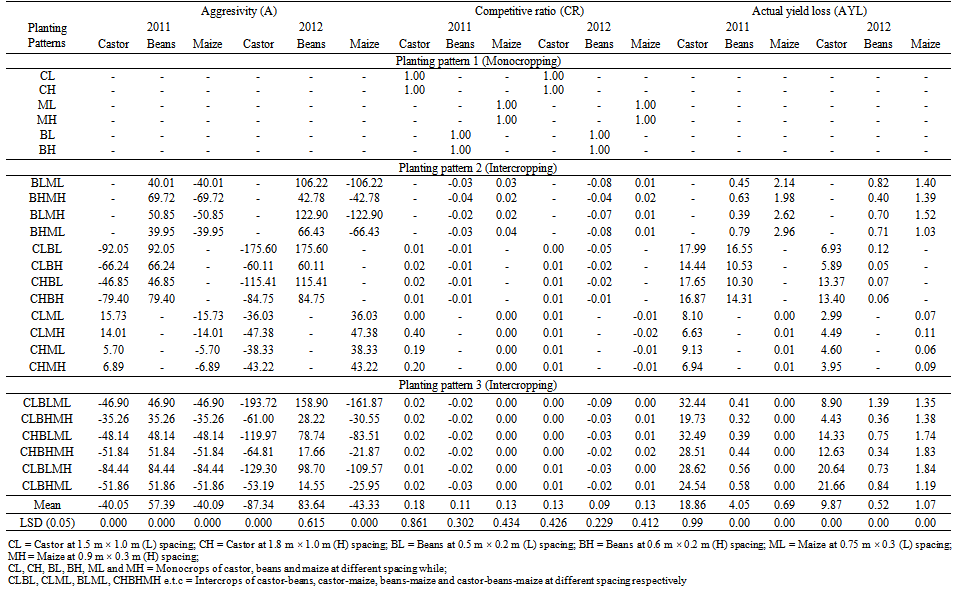 | Table 3. Aggresivity (A), competitive ratio (CR) and actual yield loss (AYL) for the various planting patterns of castor, maize and beans |
|
3.8. Land Equivalent Ratio (LER)
- The different planting patterns showed similar trends for the two seasons with the planting patterns involving maize-beans recording high LER values (2.30) followed by castor-beans (1.99) and lastly castor-maize (1.20) (Table 6). Furthermore, results indicated high LER values of above 2.20 for castor-beans intercrop at 1.5 m × 1.0 m and 0.5 m × 0.2 m spacing for castor and beans respectively. It was also showed that the individual crops species of castor and beans had LER values of above one (1) under all planting patterns in season one. These findings indicated that these intercropping systems had yield advantage over the corresponding monocrops in terms of the better use of land and environmental resources for plant growth[21]. In contrast, maize indicated low LER values with castor-maize and castor-maize-beans recording values of between 0.0 – 0.08 while maize-beans reporting values of 0.89 – 1.60 for the individual maize crop in the first season. In the second season, castor reported low LER values of below one (1). These results were also similar to those of maize under all planting patterns with records of low LER values being reported. However, beans recorded values of above one (1) at all spacing of maize and beans while similar reports were also shown for castor-beans intercrop at 1.5 m × 1.0 m and 0.5 m × 0.2 m spacing for castor and beans respectively. It was generally concluded that castor-beans intercrop at 1.5 m × 1.0 m and 0.5 m × 0.2 m spacing for castor and beans respectively, was the best cropping mixture. Similar experimental results have been reported in the past. Gupta and Rathore[22] indicated high castor equivalent yield, land equivalent ratio and net returns under castor with green grams. These findings might indicate the compatibility of castor with leguminous crops hence providing an entry point for the on-farm biofuel production with food crops. Furthermore, the higher seed yield and the net income under castor and beans intercropping system could be explained in the higher total productivity especially under intercropping with less input investment[23].
3.9. Monetary Advantage Index (MAI) Analysis
- Monetary advantage index (MAI) values found to be positive and higher for castor at all planting patterns within the first season, except for castor at 1.8 m × 1.0 m with either beans at 0.6 m × 0.2 m or maize at 0.9 m × 0.3 m spacing respectively (Table 7). Castor-beans cropping system at 1.5 m × 1.0 m spacing for castor and beans at 0.5 m × 0.2 m spacing, proved the most feasible planting pattern of castor with food crops, with results indicating MAI values of 31260 in the first season. In contrast, maize recorded high but negative and in some cases zero (0) MAI values at all planting patterns. In the second season, the MAI values were showed to be negative for castor and maize, and at all planting patterns. However, beans at 0.5 m × 0.2 m spacing, recorded significantly positive values for MAI at all planting patterns. Most importantly, positive MAI results were recorded by the beans crop at 0.5 m × 0.2 m spacing under castor at 1.5 m × 1.0 m intercropping system. The corresponding maize-beans planting patterns recorded negative MAI values, however, the individual crop MAI values indicated positive values for beans at all planting patterns. In contrast, maize showed negative MAI values at all planting patterns except under beans at 0.6 m × 0.2 m with maize at 0.9 m × 0.3 m spacing respectively.
3.10. Castor Seed Oil Content and Yield
- Intercropping of castor with maize and beans did not show any significant difference on the castor seed oil content (Table 8). Results indicated seed oil content in the range of 39.2 - 41.6% with a mean of 40% for this cultivar. However, the oil yield in ton ha-1 yr-1 was different for each planting patterns with high yields recorded for an intercrop of castor (1.5 m × 1.0 m) with either maize or beans. Castor seeds have been shown to contain oil in the range of 30 – 55% with oil yields between 1.25 – 2.5 ton ha-1 yr-1[24,25].
4. Conclusions
- It was concluded that castor could be grown productively with beans without negatively influencing food crop production, castor seed yield and seed oil content. It was recommended that for high castor seed and oil yield, an intercrop of castor with beans at spacing of 1.5 m × 1.0 m and 0.5 m × 0.2 m for castor and beans respectively could be adopted by smallholder farmers and that an intercrop of castor with maize should be discourage as this could aggravate the already worsening food situation to smallholder framers. However, further research is recommended at a wider spacing of castor with maize or an intercrop of maize with dwarf castor cultivars.
|
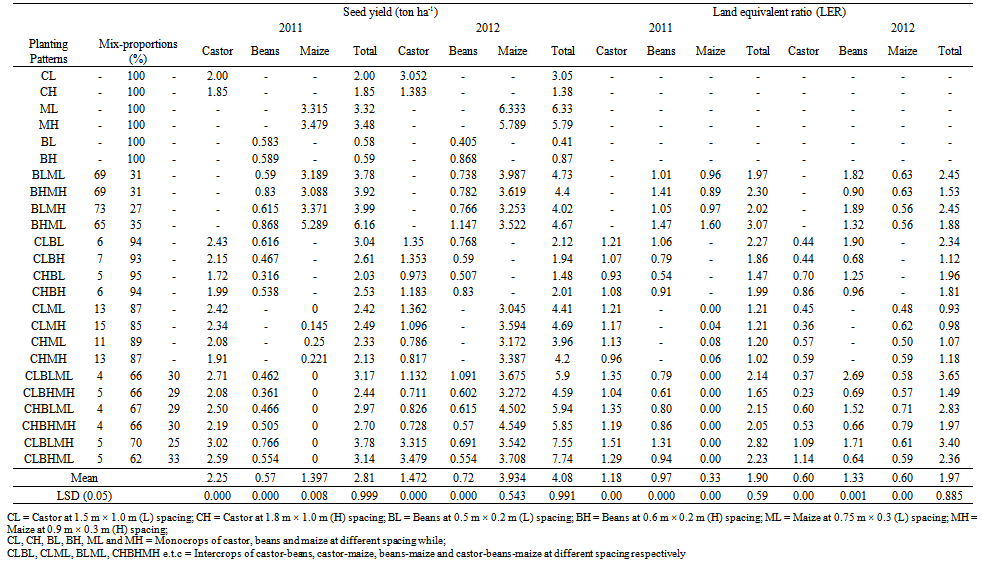 | Table 6. Seed yield (ton ha-1) and land equivalent ratio (LER) for sole crops and different mixture of castor, maize and beans |
|
|
ACKNOWLEDGEMENTS
- The authors wish to thank Egerton University, BOKU University, Vienna, Szeged University, Hungary; ERAARD and KARI – Njoro Kenya for funding this work through the PROBIOFUEL Project with grant number 7933007352.
 Abstract
Abstract Reference
Reference Full-Text PDF
Full-Text PDF Full-text HTML
Full-text HTML